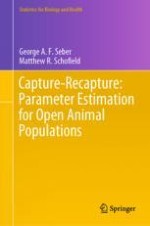2019 | OriginalPaper | Buchkapitel
15. Statistical Computation
verfasst von : George A. F. Seber, Matthew R. Schofield
Erschienen in: Capture-Recapture: Parameter Estimation for Open Animal Populations
Aktivieren Sie unsere intelligente Suche, um passende Fachinhalte oder Patente zu finden.
Wählen Sie Textabschnitte aus um mit Künstlicher Intelligenz passenden Patente zu finden. powered by
Markieren Sie Textabschnitte, um KI-gestützt weitere passende Inhalte zu finden. powered by
